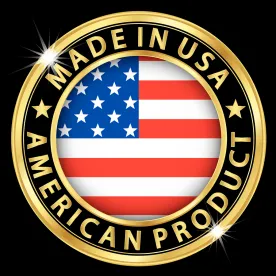Few phrases sum up the Trump administration’s policy goals better than “Buy American.” We hear it in advertising; we hear it in the State of the Union; and we find it littered throughout government buying priorities. Here is a short primer on some recent developments out of the White House regarding the oft-invoked (and often misunderstood) requirement to “Buy American,” including a new Executive Order issued just last month.
New Executive Order 13858
On January 31, 2019, President Trump signed Executive Order 13858, “Strengthening Buy-American Preferences for Infrastructure Projects,” reemphasizing the executive branch’s policy preference (but not necessarily mandate) “to maximize…the use of goods, products, and materials produced in the United States, in Federal procurements and through the terms and conditions of Federal financial assistance awards.” This policy was expressed originally in Executive Order 13788, “Buy American, Hire American,” which President Trump signed on April 18, 2017. (Discussed previously here.), Executive Order 13788 directed federal agencies to “scrupulously” monitor, enforce, and comply with various “Buy American” laws.
At first glance, the new Executive Order 13858 does not seem to have many immediate ramifications for government contractors. Its mandate is largely aspirational, asking agencies:
- To implement in the next 90 days plans to “encourage recipients of new Federal financial assistance awards pursuant to a covered program to use, to the greatest extent practicable, iron and aluminum as well as steel, cement, and other manufactured products produced in the United States in every contract, subcontract, purchase order, or sub‑award that is chargeable against such Federal financial assistance award.” (Emphasis added).
- To submit within 120 days a report on their plans to maximize the use of products produced within the United States.
Essentially, the key “update” in this new Executive Order is that it provides greater granularity on the types of materials in which President Trump is most interested (e.g., construction materials such as iron, aluminum, steel, cement, plastic/PVC piping, glass, lumber), as well as the types of government programs on which he is most focused – not necessarily direct purchases through “procurement contracts,” but more particularly infrastructure and construction spending, much of which runs through State and local government spending money obtained through federal grant programs (including, for example, grants issued by the U.S. Department of Transportation, the Federal Highway Administration (FHWA), the Federal Transit Administration (FTA), the Federal Aviation Administration (FAA), etc.).
It is difficult to know if this latest policy “push” will remain aspirational (merely “encouraging” companies to “Buy American,” which will not immediately change any requirements), or whether agencies will implement new regulations to “encourage” by force. While the Trump administration has taken a clear hands-off approach to most regulatory regimes since 2017, it seems unlikely that “Buy American” requirements will be ignored, suggesting the regulations will change (eventually). But even more troubling is whether grant recipients will respond to the “encouragement” in Executive Order 13858 with a heavy handedness all their own. If State or local authorities start imposing ad hoc “Buy American” requirements on the simple premise that it will be better for the country at large (a debatable proposition, to say the least), then this Executive Order could presage a compliance nightmare for construction contractors and their suppliers.
Still, it is difficult to predict how quickly the effects of this new Executive Order will play out. While the Executive Order imposed deadlines arriving in May 2019, history tells us it seems unlikely that any definitive solutions will be implemented by that time. Executive Order 13788 (issued in April 2017), also asking agencies to assess what they should do differently to strengthen “Buy American” requirements, imposed timelines as well. That Executive Order was mostly a vision statement, coupled with a data call, requiring agencies to submit reports within two to seven months. Reports were submitted to the White House (well past the deadline, of course), but there has been no public action from agencies in terms of rulemaking or public notice in the Federal Register. (Interestingly, on June 6, 2018, a group of Senators led by Senator Debbie Stabenow (D-Mich.) introduced the Keep Buying American Act of 2018 (S. 3006), which sought to require federal agencies to release publicly the reports mandated by Executive Order 13788. The bill died in Committee. This is only one of many new bills introduced in Congress designed to strengthen the government’s “Buy American” obligations). Given the administrative drag in responding to Executive Order 13788, it is difficult to imagine any sort of binding effect of the 90 or 120 days set forth in the new Executive Order 13858. We suspect it will be well past the deadline before we hear anything from the various agencies, but we will continue to monitor developments as they occur.
December 2018 GAO Report on the Buy American Act
Executive Order 13858 followed a recent December 2018 report from the Government Accountability Office (GAO) evaluating how federal agencies implement the Buy American Act (BAA), 41 U.S.C. §§ 8301-8305. GAO-19-17, “Buy American Act: Actions Needed to Improve Exception and Waiver Reporting and Selected Agency Guidance,” analyzed the extent to which: (a) federal agencies procure non-domestic end products via BAA exceptions and waivers; and (b) selected agencies (the U.S. government’s largest buyers), provide training and guidance to implement BAA requirements.
The BAA establishes a preference for domestic end products – that is, products manufactured or produced in the United States – but (even though its name would seem to indicate to the contrary) the BAA does not impose an absolute requirement for the government to “Buy American.” The Act carves out certain exceptions under which agencies are not required to provide preferential treatment for domestic-origin goods. The GAO report grouped these exceptions into four categories: (1) products purchased for use outside the United States; (2) products procured from U.S. Department of Defense (DoD) “qualifying countries” (where certain Memoranda of Understanding between the DoD and 27 separate allied Ministries of Defense agree not to discriminate against foreign-origin goods; see DFARS 225.003); (3) products falling under the Trade Agreements Act (TAA) waiver, by which the BAA is waived pursuant to the terms in U.S.-signed international free trade agreements; and (4) products covered by other FAR and DFARS exceptions to the BAA, including: (i) the public interest (FAR 25.103(a)); (ii) domestic non-availability determinations (FAR 25.103(b)); (iii) where the government would pay an unreasonably high cost for the domestic end product (FAR 25.103(c)); (iv) commissary resale (FAR 25.103(d)); and (v) purchases of commercial information technology (FAR 25.103(e)).
As depicted below, the GAO ultimately determined that, for FY2017, the amount of foreign-origin end products purchased by the government amounted to only $7.8 billion, constituting less than 5% of the $196 billion total the government spent on end products. That statistic is diminished even further when compared to the federal government’s total $508 billion procurement spending obligation in FY2017 – foreign end products make up only 1.5% of that overall figure. Over 80% of the $7.8 billion in foreign-origin end products were products purchased by the DoD, either purchased for use outside the U.S. or from “qualifying countries.” The remaining foreign-origin end products were split between the two other categories: TAA waivers, and those falling under the other FAR and DFARS exceptions to the BAA (listed above). That the TAA waiver was among the smallest category of excepted purchases, at only $550 million, is somewhat surprising, given that it tends to be the most well-known exception to the BAA.
FEDERAL OBLIGATIONS FOR FOREIGN END PRODUCTS, FISCAL YEAR 2017
Interestingly, the GAO noted the possibility its conclusions were incomplete, given the data reviewed by GAO was incomplete. The GAO observed the Office of Management and Budget (OMB) is currently considering strategies to improve Buy American Act data – strategies that will, no doubt, be informed by the reports issued in response to the April 2017 Executive Order 13788 and other governmental pushes to implement President Trump’s “Buy American” priorities.
In the second part of the GAO report, the GAO determined there is significant variance between agencies in providing BAA training and guidance, largely due to differences in the training programs and materials various agencies use. For instance, DoD made a point to re-emphasize BAA training in 2017, committing to having 18,000 employees complete a BAA training course by September 2018. On the other hand, neither the Departments of Veteran’s Affairs (VA) or Health and Human Services (HHS) included BAA-specific training for their personnel, a deficiency the GAO recommended be corrected.
Conclusion
Overall, the GAO data indicates that, while BAA compliance remains a priority of the U.S. government and the Trump administration, requiring agencies to “Buy American” through traditional government contracts may have a minimal impact in the overall scheme of things (with the data seeming to indicate that there is only a $7.8 billion opportunity for domestic manufacturers). This realization may be why the White House has now shifted its focus to grant-related incentives under the January 2019 Executive Order 13858, which seems to be a much larger piece of the federal-spending pie. According to USASpending.gov, the federal government doled out over $755 billion in grant awards in FY2018. This is nearly 150% of the approximately $508 billion federal procurement spending in FY2017.
It goes without saying that contractors are well-advised to continue ensuring BAA compliance where required, closely monitoring country of origin requirements in their contracts, and then ensuring that the products purchased through the supply chain match the contract requirements. Going forward, there is a greater likelihood that contracting entities at all levels will increase their scrutiny of contractors’ country of origin certifications as a result of these recent policy updates, and not only will accurate and auditable “Buy America” certifications prevent potentially severe consequences for noncompliance, but they could also provide a distinct advantage when competing for contract and grant awards. We can only hope, however, that any new “Buy American” rules or regulations will be uniformly implemented (especially given the GAO’s recommendation to improve training government-wide), after giving the public plenty of opportunity to comment on the wisdom of the policy choices, instead of being implemented on an ad hoc basis as overzealous buyers implement their own sense of what the BAA should require in response to the President’s “encouragement.”
Be careful out there. And please let us know if we can help you navigate the ever-evolving “Buy American” maze.




 />i
/>i

